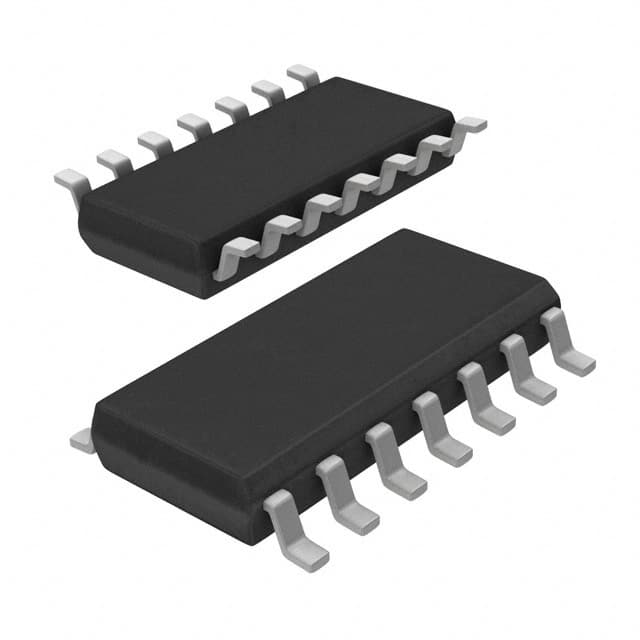Viz Specifikace pro podrobnosti o produktu.

74LVTH125D,118
Basic Information Overview
- Category: Integrated Circuit (IC)
- Use: Logic Level Translator
- Characteristics: High-speed, low-power, voltage-level shifting
- Package: SOIC-14
- Essence: Quad buffer/line driver with 3-state outputs
- Packaging/Quantity: Tape and reel, 2500 pieces per reel
Specifications
- Supply Voltage Range: 2.7V to 3.6V
- High-Level Input Voltage: 2.0V to VCC + 0.5V
- Low-Level Input Voltage: -0.5V to 0.8V
- High-Level Output Voltage: VCC - 0.5V
- Low-Level Output Voltage: 0.5V
- Maximum Operating Frequency: 200MHz
- Propagation Delay Time: 3.4ns (typical)
Detailed Pin Configuration
The 74LVTH125D,118 IC has a total of 14 pins. The pin configuration is as follows:
__ __
Y1 |1 \/ 14| VCC
A1 |2 13| Y4
A2 |3 12| A4
Y2 |4 11| OE#
GND |5 10| A3
Y3 |6 9| Y4
A3 |7 8| A4
-- --
Functional Features
- Quad buffer/line driver with 3-state outputs
- Provides voltage level translation between different logic families
- Allows bidirectional communication between systems operating at different voltage levels
- Supports high-speed data transfer up to 200MHz
- Low power consumption for energy-efficient applications
- 3-state outputs enable bus sharing and reduce contention issues
Advantages
- High-speed operation allows for efficient data transfer
- Low power consumption helps in reducing overall system energy usage
- 3-state outputs facilitate bus sharing and minimize conflicts
- Wide supply voltage range enables compatibility with various systems
- Small package size (SOIC-14) offers space-saving benefits
Disadvantages
- Limited to voltage level translation between specific logic families
- Not suitable for applications requiring translation between non-standard voltage levels
- Propagation delay may affect timing-sensitive applications
Working Principles
The 74LVTH125D,118 is a quad buffer/line driver IC designed to perform voltage level translation between different logic families. It operates by receiving input signals from one logic family and translating them into output signals compatible with another logic family. The device utilizes a combination of MOSFETs and CMOS technology to achieve high-speed operation and low power consumption.
The IC features 3-state outputs, which allow multiple devices to share a common bus without causing conflicts. When the output enable (OE#) pin is set to a high logic level, the outputs are in a high-impedance state, effectively disconnecting the device from the bus.
Detailed Application Field Plans
The 74LVTH125D,118 is commonly used in various applications that require voltage level translation between different logic families. Some typical application fields include: 1. Microcontroller interfacing with different peripheral devices operating at different voltage levels. 2. Communication interfaces between systems using different logic families, such as TTL and CMOS. 3. Level shifting in mixed-signal circuits, where analog and digital components operate at different voltage levels. 4. Bus sharing in multiprocessor systems, allowing multiple devices to communicate over a shared bus.
Detailed and Complete Alternative Models
Some alternative models that provide similar functionality to the 74LVTH125D,118 include: - 74LVC125A: Quad buffer/line driver with 3-state outputs, compatible with a wider supply voltage range. - SN74LVC1T45: Single-bit dual-supply bus transceiver, suitable for bidirectional level translation. - NC7WZ125: TinyLogic UHS buffer/line driver, designed for space-constrained applications.
These alternative models offer similar features and can be used as substitutes depending on specific requirements and system constraints.
In conclusion, the 74LVTH125D,118 is a versatile logic level translator IC that enables voltage level translation between different logic families. Its high-speed operation, low power consumption, and 3-state outputs make it suitable for various applications in different fields. However, it is important to consider its limitations and explore alternative models when necessary.
Seznam 10 běžných otázek a odpovědí souvisejících s aplikací 74LVTH125D,118 v technických řešeních
Sure! Here are 10 common questions and answers related to the application of 74LVTH125D,118 in technical solutions:
Q: What is the function of the 74LVTH125D,118? A: The 74LVTH125D,118 is a quad buffer/line driver with 3-state outputs.
Q: What is the voltage supply range for the 74LVTH125D,118? A: The voltage supply range is typically between 2.7V and 3.6V.
Q: Can the 74LVTH125D,118 be used in both digital and analog applications? A: No, it is primarily designed for digital applications.
Q: What is the maximum output current that the 74LVTH125D,118 can handle? A: The maximum output current is typically around 12mA.
Q: Is the 74LVTH125D,118 compatible with TTL logic levels? A: Yes, it is fully compatible with TTL logic levels.
Q: Can the 74LVTH125D,118 be used as a level shifter? A: Yes, it can be used as a level shifter between different voltage domains.
Q: What is the propagation delay of the 74LVTH125D,118? A: The typical propagation delay is around 3.5ns.
Q: Can the 74LVTH125D,118 drive capacitive loads? A: Yes, it can drive capacitive loads up to a certain limit specified in the datasheet.
Q: Does the 74LVTH125D,118 have built-in protection against electrostatic discharge (ESD)? A: Yes, it has built-in ESD protection to prevent damage from static electricity.
Q: Can the 74LVTH125D,118 be used in high-speed applications? A: Yes, it is suitable for high-speed applications due to its low propagation delay and high-speed operation.
Please note that these answers are general and may vary depending on the specific application and conditions. Always refer to the datasheet and consult with an expert when designing technical solutions.

